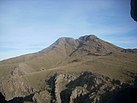
Back Buenos Aires (provinsie) Afrikaans بوينس آيرس (محافظة) Arabic Provincia de Buenos Aires AST Buenos Aires jisk'a suyu Aymara بوئنوس آیرس ایالتی AZB Provinz Buenos Aires BAR Buenas Airiu provincėjė BAT-SMG Буэнас-Айрэс (правінцыя) Byelorussian Буэнас-Айрэс (правінцыя) BE-X-OLD Буенос Айрес (провинция) Bulgarian
Buenos Aires
Provincia de Buenos Aires (Spanish) | |
|---|---|
From top, left to right: view of downtown La Plata, view of Carmen de Patagones by the Río Negro, cliffs in the Atlantic Coast, Cerro Tres Picos, the Basilica of Our Lady of Luján, a natural landscape of the Pampas, view of Mar del Plata and view of Tandil. | |
 Location of Buenos Aires Province within Argentina | |
| Coordinates: 37°S 60°W / 37°S 60°W | |
| Country | Argentina |
| Capital | La Plata |
| Government | |
| • Governor | Axel Kicillof (PJ-UxP) |
| • Vice Governor | Verónica Magario (PJ-UxP) |
| • Legislature | Chamber of Deputies (92) Senate (46) |
| • National Deputies | 70 |
| • National Senators | Maximiliano Abad (UCR) Eduardo de Pedro (PJ) Juliana Di Tullio (PJ) |
| Area | |
| • Total | 307,571 km2 (118,754 sq mi) |
| Population (2022 census[1]) | |
| • Total | 17,569,053 |
| • Rank | 1st |
| • Density | 57/km2 (150/sq mi) |
| Demonym | bonaerense |
| GDP | |
| • Total | peso 7,573 billion (US$162 billion) (2019)[2] |
| Time zone | UTC−03:00 (ART) |
| Postal codes | B1601XXX to B8512XXX[3] |
| ISO 3166 code | AR-B |
| HDI (2021) | 0.842 very high (11th)[4] |
| Website | www |
Buenos Aires,[a] officially the Buenos Aires Province,[b] is the largest and most populous Argentine province. It takes its name from the city of Buenos Aires, the capital of the country, which used to be part of the province and the province's capital until it was federalized in 1880. Since then, in spite of bearing the same name, the province does not include Buenos Aires city, though it does include all other parts of the Greater Buenos Aires metropolitan area. The capital of the province is the city of La Plata, founded in 1882.
It is bordered by the provinces of Entre Ríos to the northeast, Santa Fe to the north, Córdoba to the northwest, La Pampa to the west, Río Negro to the south and west and the Autonomous City of Buenos Aires to the northeast. Uruguay is just across the Rio de la Plata to the northeast, and both are on the coast of the Atlantic Ocean to the east. Almost the entire province is part of the Pampas geographical region, with the extreme south often considered part of the Patagonia region.
The province has a population of about 17.5 million people, which is 38% of Argentina's total population. The province covers an area of 307,571 km2 (118,754 sq mi), which is about 11% of Argentina's total area and makes it the country's largest province.
- ^ "Distribución de la población por jurisdicción. Total del país. Año 2022" (in Spanish). Instituto Nacional de Estadística y Censos. Archived from the original on 8 April 2023. Retrieved 18 March 2023.
- ^ "PBG Buenos Aires 2019" (PDF). Archived (PDF) from the original on 2024-01-18. Retrieved 2023-12-27.
- ^ "Buenos Aires Postal Codes". zippinpostal.com. Retrieved 27 February 2024.
- ^ "El mapa del desarrollo humano en Argentina" (PDF). United Nations Development Programme. 25 June 2023. Archived (PDF) from the original on 11 June 2023. Retrieved 26 June 2023.
Cite error: There are <ref group=lower-alpha> tags or {{efn}} templates on this page, but the references will not show without a {{reflist|group=lower-alpha}} template or {{notelist}} template (see the help page).
© MMXXIII Rich X Search. We shall prevail. All rights reserved. Rich X Search









